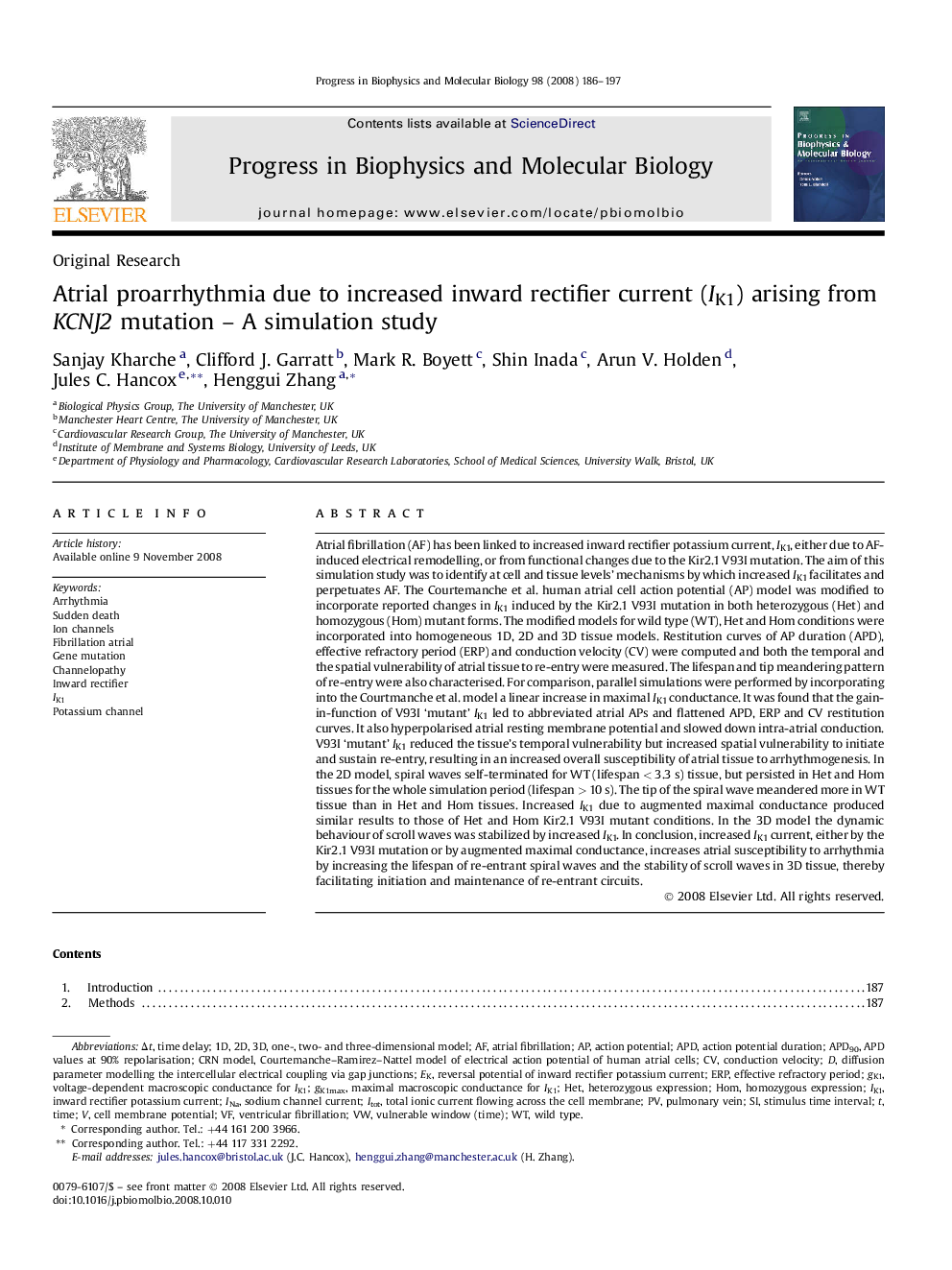| کد مقاله | کد نشریه | سال انتشار | مقاله انگلیسی | نسخه تمام متن |
|---|---|---|---|---|
| 8401722 | 1544494 | 2008 | 12 صفحه PDF | دانلود رایگان |
عنوان انگلیسی مقاله ISI
Atrial proarrhythmia due to increased inward rectifier current (IK1) arising from KCNJ2 mutation - A simulation study
دانلود مقاله + سفارش ترجمه
دانلود مقاله ISI انگلیسی
رایگان برای ایرانیان
کلمات کلیدی
δtgK11D, 2D, 3Dsodium channel currentIK1APD90ChannelopathyAPDINa - INAHET - ITArrhythmia - آریتمیERP - برنامه ریزی منابع سازمانTime delay - تاخیر زمانیInward rectifier potassium current - جریان پتاسیم یکسو کننده داخلیGene mutation - جهش ژنیeffective refractory period - دوره رفع موثرpulmonary vein - رگ ریویTime - زمان Conduction velocity - سرعت هدایتVentricular fibrillation - فیبریلاسیون بطنیAtrial fibrillation - فیبریلاسیون دهلیزیAction potential duration - مدت زمان بالقوه عملSudden death - مرگ ناگهانیhom - منمwild type - نوع وحشیaction potential - پتانسیل عمل Cell membrane potential - پتانسیل غشای سلولیIon channels - کانال های یونیPotassium channel - کانال پتاسیمInward rectifier - یکسو کننده داخلی
موضوعات مرتبط
علوم زیستی و بیوفناوری
بیوشیمی، ژنتیک و زیست شناسی مولکولی
بیوفیزیک
پیش نمایش صفحه اول مقاله

چکیده انگلیسی
Atrial fibrillation (AF) has been linked to increased inward rectifier potassium current, IK1, either due to AF-induced electrical remodelling, or from functional changes due to the Kir2.1 V93I mutation. The aim of this simulation study was to identify at cell and tissue levels' mechanisms by which increased IK1 facilitates and perpetuates AF. The Courtemanche et al. human atrial cell action potential (AP) model was modified to incorporate reported changes in IK1 induced by the Kir2.1 V93I mutation in both heterozygous (Het) and homozygous (Hom) mutant forms. The modified models for wild type (WT), Het and Hom conditions were incorporated into homogeneous 1D, 2D and 3D tissue models. Restitution curves of AP duration (APD), effective refractory period (ERP) and conduction velocity (CV) were computed and both the temporal and the spatial vulnerability of atrial tissue to re-entry were measured. The lifespan and tip meandering pattern of re-entry were also characterised. For comparison, parallel simulations were performed by incorporating into the Courtmanche et al. model a linear increase in maximal IK1 conductance. It was found that the gain-in-function of V93I 'mutant' IK1 led to abbreviated atrial APs and flattened APD, ERP and CV restitution curves. It also hyperpolarised atrial resting membrane potential and slowed down intra-atrial conduction. V93I 'mutant' IK1 reduced the tissue's temporal vulnerability but increased spatial vulnerability to initiate and sustain re-entry, resulting in an increased overall susceptibility of atrial tissue to arrhythmogenesis. In the 2D model, spiral waves self-terminated for WT (lifespan < 3.3 s) tissue, but persisted in Het and Hom tissues for the whole simulation period (lifespan > 10 s). The tip of the spiral wave meandered more in WT tissue than in Het and Hom tissues. Increased IK1 due to augmented maximal conductance produced similar results to those of Het and Hom Kir2.1 V93I mutant conditions. In the 3D model the dynamic behaviour of scroll waves was stabilized by increased IK1. In conclusion, increased IK1 current, either by the Kir2.1 V93I mutation or by augmented maximal conductance, increases atrial susceptibility to arrhythmia by increasing the lifespan of re-entrant spiral waves and the stability of scroll waves in 3D tissue, thereby facilitating initiation and maintenance of re-entrant circuits.
ناشر
Database: Elsevier - ScienceDirect (ساینس دایرکت)
Journal: Progress in Biophysics and Molecular Biology - Volume 98, Issues 2â3, OctoberâNovember 2008, Pages 186-197
Journal: Progress in Biophysics and Molecular Biology - Volume 98, Issues 2â3, OctoberâNovember 2008, Pages 186-197
نویسندگان
Sanjay Kharche, Clifford J. Garratt, Mark R. Boyett, Shin Inada, Arun V. Holden, Jules C. Hancox, Henggui Zhang,